Class 8 History Chapter 7 Notes - Women, Caste and Reform
| Table of contents |

|
| Overview |

|
| Working Towards Change |

|
| Caste and Social Reform |

|
| Important Dates |

|
Overview
Two hundred years ago, children were married off at an early age. Hindu and Muslim men could have multiple wives. Widows were expected to commit sati (burning themselves on their husbands' funeral pyres). Women had limited rights to property and little access to education. Society was divided by caste, with Brahmins and Kshatriyas at the top and "untouchables" at the bottom. They were not allowed to enter temples, draw water from the wells used by the upper castes, or bathe in ponds where upper castes bathed. Over the 19th and 20th centuries, norms and perceptions began to change.
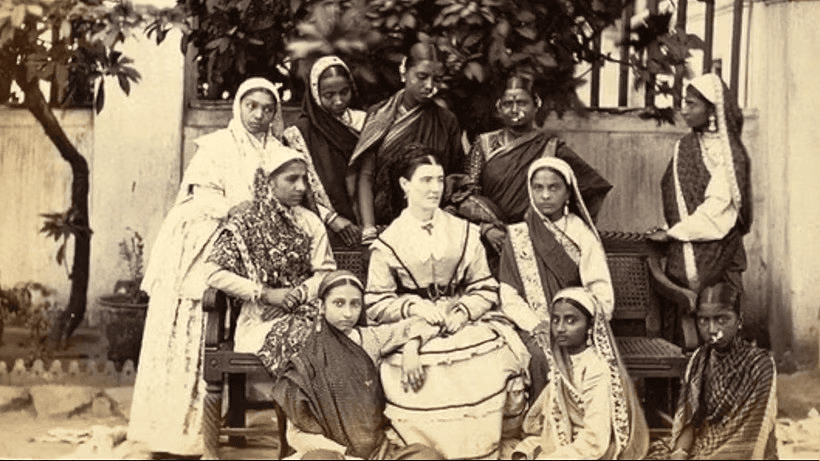
Working Towards Change
- The development of new forms of communication in the early nineteenth century led to debates and discussions about social customs and practices taking on a new character.
- Books, newspapers, magazines, leaflets, and pamphlets were printed for the first time, making information more accessible to ordinary people.
- These new forms of communication allowed for the discussion of various issues, including social, political, economic, and religious matters.
- Men and sometimes women in the new cities could now debate and discuss these issues, reaching out to a wider public.
- Indian reformers and reform groups initiated many of these debates, with Raja Rammohun Roy (1772–1833) being one such reformer. He founded a reform association known as the Brahmo Sabha (later known as the Brahmo Samaj) in Calcutta.
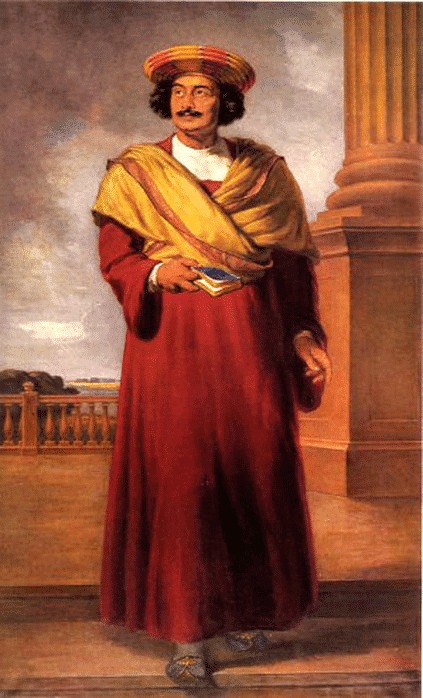
- Reformers like Rammohun Roy believed that changes were necessary in society and that unjust practices needed to be eliminated.
- They sought to persuade people to give up old practices and adopt a new way of life.
- Rammohun Roy focused on spreading Western education and advocating for greater freedom and equality for women.
- He criticized the burden of domestic work on women and their confinement to the home, advocating for their education and empowerment.
Changing the Lives of Widows
- Rammohun Roy was concerned about the problems faced by widows and campaigned against the practice of sati.
- He used his knowledge of various languages to show that the practice of widow burning had no support in ancient texts.
- British officials in the early 19th century also criticized Indian traditions and customs and were willing to listen to Rammohun.
- In 1829, the practice of sati was banned.
- Rammohun's method of using ancient texts to challenge harmful practices was adopted by later reformers.
- Ishwarchandra Vidyasagar used ancient texts to suggest that widows could remarry, which was later adopted into law in 1856. (Hindu Widow Remarriage Act, 1856)
- The movement for widow remarriage spread to other parts of the country.
- Veerasalingam Pantulu formed an association for widow remarriage in the Telugu-speaking areas.
- Young intellectuals and reformers in Bombay also pledged to work for widow remarriage.
- Swami Dayanand Saraswati, founder of Arya Samaj, also supported widow remarriage.
- Despite the new law, the number of widows who actually remarried remained low and faced opposition from conservative groups.
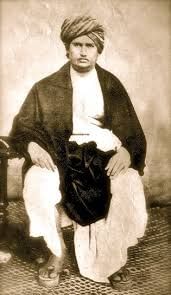
Note: In this popular festival named Hook Swinging Festival, devotees underwent a peculiar form of suffering as part of ritual worship.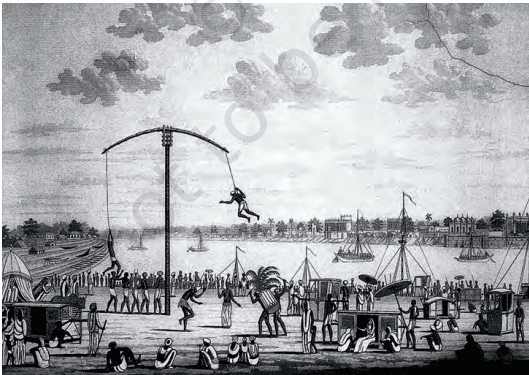
Girls Begin Going to School
- Many reformers believed that educating girls was necessary for improving women's condition.
- Schools for girls were established by reformers like Vidyasagar and Jyotirao Phule.

- Initially, there was resistance to girls' education due to fears of taking them away from domestic duties and corrupting influences.
- Educated women were mostly taught at home by liberal fathers or husbands, or they taught themselves.
- The Arya Samaj and Jyotirao Phule established schools for girls in Punjab and Maharashtra.
- In aristocratic Muslim households, women learned to read the Koran in Arabic with the help of female teachers.
- Some reformers reinterpreted verses from the Koran to advocate for women's education.
- Urdu novels were written to encourage women to read about religion and domestic management in a language they could understand.
Women write about Women
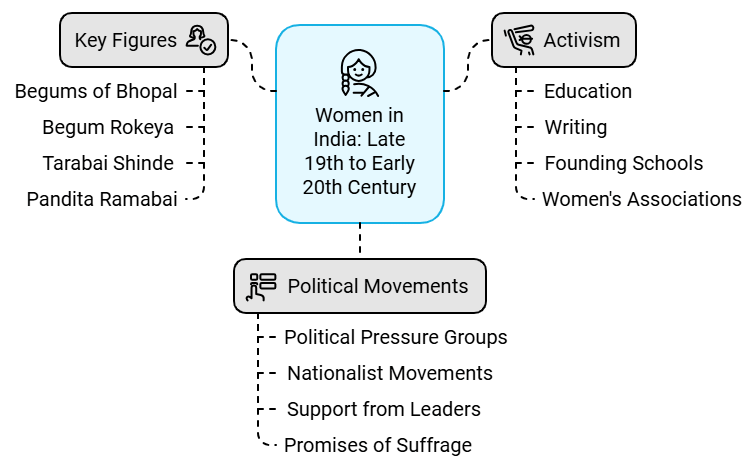
- In the early twentieth century, Muslim women like the Begums of Bhopal and Begum Rokeya Sakhawat Hossain played a significant role in promoting education for women.
- Indian women began entering universities and pursuing careers as doctors and teachers in the 1880s.
- Many women began to write and publish their critical views on the place of women in society. Tarabai Shinde, a woman educated at home at Poona, published a book, Stripurushtulna, (A Comparison between Women and Men), criticising the social differences between men and women (Men Dominant Society).
- Pandita Ramabai criticized Hinduism for its oppression of women and founded a widows' home to provide support for mistreated widows.
- Women's activism alarmed orthodox Hindus and Muslims who feared the adoption of Western ways and the erosion of cultural and family values.
- By the end of the nineteenth century, women were actively working for reform through writing, founding schools, and setting up women's associations.
- In the twentieth century, women formed political pressure groups and joined nationalist and socialist movements to advocate for female suffrage, improved healthcare, and education.
- Leaders like Jawaharlal Nehru and Subhas Chandra Bose supported women's demands for equality and freedom.
- Nationalist leaders promised full suffrage for men and women after Independence, but encouraged women to focus on the anti-British struggles until then.
Law against child marriage
With the rise of women's organizations and discussions on these issues, the push for reform gained momentum. One significant challenge was to the practice of child marriage. Many Indian legislators in the Central Legislative Assembly worked to pass a law to prevent child marriage. In 1929, the Child Marriage Restraint Act was enacted with less controversy than previous laws. This Act initially set the minimum marriage age at 18 for men and 16 for women. Later, these age limits were increased to 21 for men and 18 for women.
Caste and Social Reform
- Social reformers like Raja Ram Mohan Roy and the Prarthana Samaj criticized caste inequalities.
- They Prarthana Samaj adhered to the tradition of Bhakti, which believed in the spiritual equality of all castes.
- The Paramhans Mandali was founded in Bombay in 1840 to work for the abolition of caste.
- Many reformers and members of reform associations were from upper castes.
- They would secretly violate caste taboos on food and touch in an effort to eliminate caste prejudice from their lives.
- Christian missionaries set up schools for tribal groups and lower-caste children to provide them with resources to navigate a changing world.
- As factories and municipalities began to grow, new labor demands emerged. Jobs were needed for digging drains, laying roads, constructing buildings, and cleaning cities.
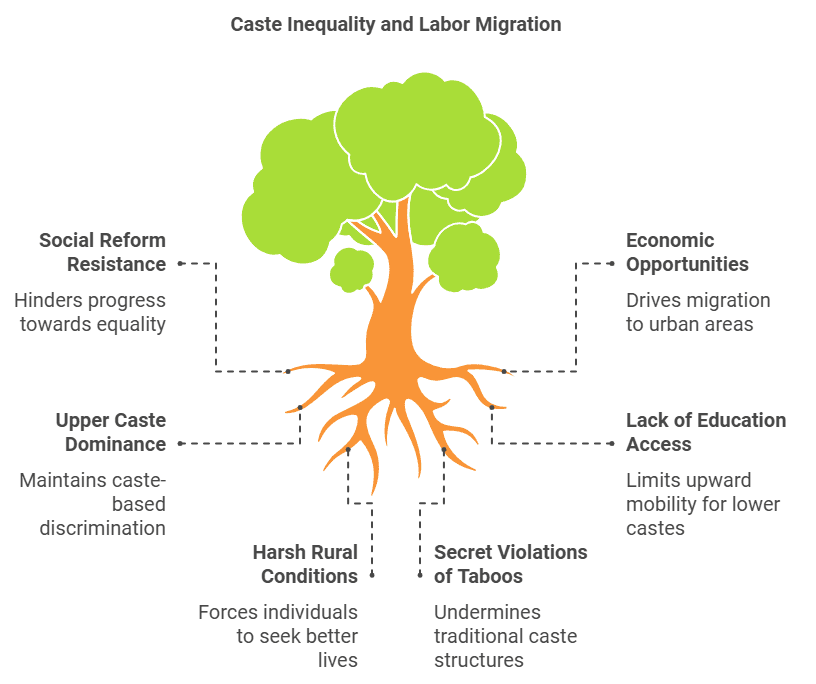
This work required laborers such as coolies, diggers, carriers, bricklayers, sewage cleaners, sweepers, palanquin bearers, and rickshaw pullers.
Many poor individuals from villages and small towns, especially those from lower castes, moved to cities to fill these new labor demands.
Some also traveled to work on plantations in places like Assam, Mauritius, Trinidad, and Indonesia.
Although the work was often difficult, these individuals saw it as an opportunity to escape the harsh control and daily humiliation imposed by upper-caste landowners in their rural areas.
There were other jobs too. The army, for instance, offered opportunities. A number of Mahar people, who were regarded as untouchable, found jobs in the Mahar Regiment.
- B.R. Ambedkar, the leader of the Dalit movement, had a father who taught at an army school.
Note:-
a) Coolie ship, 19th century – named John Allen – carried many Indian labourers to Mauritius where they did a variety of forms of hard labour. b) Madigas made shoes, were an important untouchable caste .They were experts at cleaning hides, tanning them for use, and sewing sandals.
c) In the Bombay Presidency, as late as 1829, untouchables were not allowed into even government schools.
d) Dublas laboured for upper-caste landowners, cultivating their fields, and working at a variety of odd jobs at the landlord’s house.
Demands for Equality and Justice
- During the second half of the nineteenth century, movements against caste discrimination emerged.
- The Satnami movement in Central India, founded by Ghasidas, aimed to improve the social status of leatherworkers.
- Haridas Thakur's Matua sect in eastern Bengal worked with Chandala cultivators and questioned Brahmanical texts supporting the caste system.
- Shri Narayana Guru, a guru from the Ezhava caste in present-day Kerala, advocated for unity and equality among all people, rejecting caste differences.
- These movements were led by individuals from non-Brahman castes and aimed to change practices that caused contempt from dominant castes and promote self-esteem among subordinate castes.
- One of Shri Narayana Guru's famous statements was "one caste, one religion, one god for humankind."
- All these sects were founded by leaders who came from NonBrahman castes and worked amongst them. They tried to change those habits and practices which provoked the contempt of dominant castes. They tried to create a sense of self-esteem among the subordinate castes.

Gulamgiri
- Jyotirao Phule was a vocal leader among the "Iow-caste" leaders in India.
- He studied in schools set up by Christian missionaries and developed his own ideas about the injustices of caste society.
- Phule attacked the Brahmins' claim of superiority, arguing that the Aryans were foreigners and the land belonged to the indigenous people.
- He believed in a golden age before Aryan rule when warrior-peasants ruled the Maratha countryside in a just and fair manner.
- Phule proposed that Shudras and Ati Shudras should unite to challenge caste discrimination.
- He founded the Satyashodhak Samaj, which advocated for caste equality.
- Phule wrote a book called Gularngiri, dedicating it to those who fought to free slaves in America, drawing a parallel between the conditions of lower castes in India and black slaves.
- Phule extended his criticism of the caste system to argue against all forms of inequality, including the plight of upper-caste women, the hardships of laborers, and the humiliation of low castes.
- His movement for caste reform was continued by other dalit leaders like Dr B.R. Ambedkar and E.V. Ramaswamy Naicker in the twentieth century.
Who Could Enter Temples?
- Ambedkar was born into a Mahar family and experienced caste prejudice in everyday life as a child.
- He was discriminated against in school, being made to sit outside the classroom and not allowed to drink water from taps used by upper-caste children.
- After completing school, he received a fellowship to study in the US and upon his return to India in 1919, he wrote extensively about the power of upper-caste in contemporary society.
- In 1927, Ambedkar initiated a temple entry movement, where his Mahar caste followers participated and the Brahman priests were outraged when the Dalits used water from the temple tank.
- Ambedkar led three temple entry movements between 1927 and 1935 to highlight the prevalence of caste prejudices within society.

The Non-Brahman Movement
- The non-Brahman movement emerged in the early twentieth century. It was led by non-Brahman castes who had gained education, wealth, and influence. They challenged the power and claims of Brahmins.
- E.V. Ramaswamy Naicker, also known as Periyar, was a key figure in the movement.
- Periyar came from a middle-class background and had studied Sanskrit scriptures.
- He left the Congress party after witnessing caste-based seating arrangements at a nationalist feast.
- Periyar founded the Self Respect Movement, advocating for the dignity and equality of untouchables.
- He argued that untouchables were the true upholders of Tamil and Dravidian culture, which had been oppressed by Brahmins.
- Periyar criticized Hindu scriptures, such as the Codes of Manu, the Bhagavad Gita, and the Ramayana, for perpetuating caste and gender inequality.
- The lower-caste leaders' activism led to some self-reflection among upper-caste nationalist leaders.
- Orthodox Hindu society responded with the establishment of associations Sanatan Dharma Sabhas and the Bharat Dharma Mahamandal in the north, and associations like the Brahman Sabha in Bengal that aimed to uphold caste distinctions.
- Debates and struggles over caste continued beyond the colonial period and are ongoing today.
Important Dates
- 1772 to 1833: lifespan of Raja Ram Mohan Roy
- 1829: Sati was banned
- 1856: widow remarriage started
- By the 1880s: Indian women began to enter universities
- 1929: the child marriage restraint Act was passed
- 1840: the paramhansmandali was founded
- 1827:JyotibaPhule was born
- 1873: JyotibaPhule wrote a book named gulamgiri
- 1927: Ambedkar started a temple entry movement
- 1830: The brahmoSamaj was founded
- 1893: Swami Vivekananda gave his speech in Chicago
- 1867: the PrarthanaSamaj was established
- 1864: the Veda Samaj was established in Chennai
- 1875: Syed Ahmed Khan founded the Anglo Oriental College
- 1873: the Singh Sabha Movement was started in Amritsar
- 1879: the Singh Sabha Movement was started in Lahore
- 1776: The American Revolution
|
69 videos|431 docs|46 tests
|
FAQs on Class 8 History Chapter 7 Notes - Women, Caste and Reform
| 1. What is the significance of caste in Indian society and how has it affected social reform? |  |
| 2. Who were some key figures in the women's rights movement during the social reform period? |  |
| 3. What role did education play in the caste and social reform movements? |  |
| 4. How did the reform movements address the issues faced by women in the context of caste? |  |
| 5. What were some important outcomes of the social reform movements on caste and women? |  |





















